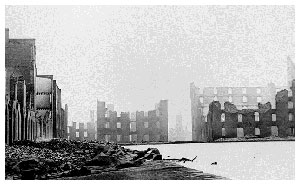 Today in 1781, the traitorous general Benedict Arnold led British forces to torch Richmond, Va., as part of the bloody “Raid on Richmond” in the wake of then-governor Thomas Jefferson’s decision to move the state capital from Williamsburg 51 miles up the James River. Emboldened, Arnold sailed the distance, setting fire to settlements en route, and finally decamping at Westover Plantation to set up a base of operations for what would be an unopposed entrance into the city. Writing to Jefferson, Arnold said he would spare Richmond if he was allowed to take the tobacco stored five miles outside of town — a valuable crop that Jefferson refused to relinquish. Angered, Arnold’s men torched government buildings and homes alike, looted and pillaged, and destroyed a local cannon foundry on the way out of town. It wouldn’t be the last time a conflagration destroyed part of Virginia’s capital city, though. Beating a retreat in the final days of the Civil War, Confederate forces set fire to Richmond’s tobacco warehouses on Apr. 3, 1865, which eventually engulfed the commercial core and destroyed 90 percent of the businesses there. “By May 10th / Richmond had fell,” to quote The Band’s Robbie Robertson in his lyrics to “The Night They Drove Old Dixie Down,” and that, as they say, was that, for the Confederacy. Pictured: The ruins of Gallego Mills, Richmond, Virginia, after the destruction by a Confederate attempt to burn Richmond, 1865. Mathew Brady collection, National Archives.
Today in 1781, the traitorous general Benedict Arnold led British forces to torch Richmond, Va., as part of the bloody “Raid on Richmond” in the wake of then-governor Thomas Jefferson’s decision to move the state capital from Williamsburg 51 miles up the James River. Emboldened, Arnold sailed the distance, setting fire to settlements en route, and finally decamping at Westover Plantation to set up a base of operations for what would be an unopposed entrance into the city. Writing to Jefferson, Arnold said he would spare Richmond if he was allowed to take the tobacco stored five miles outside of town — a valuable crop that Jefferson refused to relinquish. Angered, Arnold’s men torched government buildings and homes alike, looted and pillaged, and destroyed a local cannon foundry on the way out of town. It wouldn’t be the last time a conflagration destroyed part of Virginia’s capital city, though. Beating a retreat in the final days of the Civil War, Confederate forces set fire to Richmond’s tobacco warehouses on Apr. 3, 1865, which eventually engulfed the commercial core and destroyed 90 percent of the businesses there. “By May 10th / Richmond had fell,” to quote The Band’s Robbie Robertson in his lyrics to “The Night They Drove Old Dixie Down,” and that, as they say, was that, for the Confederacy. Pictured: The ruins of Gallego Mills, Richmond, Virginia, after the destruction by a Confederate attempt to burn Richmond, 1865. Mathew Brady collection, National Archives.
NCPA
